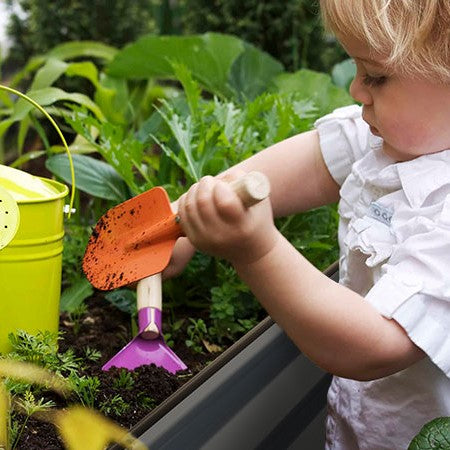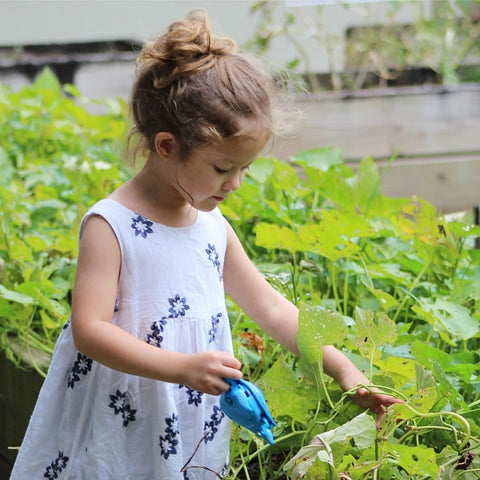Gardening with children is fun! My favorite childhood memories include gardening with my grandparents. Tasting the fresh onions and carrots on the garden bed really gave me the inspiration for today's garden. Most children can get something from gardening. Tasting fresh agricultural products is a good way to let them participate in this process.The following content also has some reference value for raised garden beds.
You may already know the benefits of staying in the yard and away from the sofa, including the benefits for the immune system and mental space. But how can we help our children engage in gardening, an activity that can last into adulthood and benefit them for life? There are many ways to do this, and we have introduced some of them here.
Let's discuss some strategies to stimulate children's general interest in gardening. By involving them, you can help them understand the seasonal cycle and the seemingly miraculous process of seeds growing into plants. This is one of the simplest and most successful ways to let children enter the garden, even at a very young age. First, ask them what they want to grow. Let them choose to plant their favorite plants, which will help them feel that they have a voice in the gardening experience. If they like blueberry pie, teach them how to grow blueberries. If they like French fries, tell them how to grow potatoes.
Or try to plant a garden bed with cherry tomatoes and herbs, such as basil, oregano, sage and garlic. The idea of a food-centered garden will not only make them interested in the delicious snacks here and there, but also help them better understand the gardening in a wider range, especially in the accompanying planting.
 Now that your children are motivated to garden, you have given them one of the best gifts. You also bring them closer to understanding how food goes from point A (seed) to point B (time to pick vegetables). If they are enthusiastic about environmental awareness and want to learn the principles of organic gardening, that is another way you can follow.
Now that your children are motivated to garden, you have given them one of the best gifts. You also bring them closer to understanding how food goes from point A (seed) to point B (time to pick vegetables). If they are enthusiastic about environmental awareness and want to learn the principles of organic gardening, that is another way you can follow.
Maybe your child is more interested in planting flowers than food crops and herbs. Maybe they want to plant several different cut flowers. Or maybe your child likes a certain habitat and plants suitable for the environment.
Your child can plant flowers or cacti, or even undergrowth plants. If you need inspiration, you can go to the nearest botanical garden. Some botanical gardens even have a children's garden to help you determine what is best for your situation.
Give them the tools they need to grow
An important factor in making your child responsible for plants is to determine the amount of space for that purpose. This kind of space is also important. Outdoor space or outdoor movable bed is as instructive as indoor space. We have a great article about indoor gardening for beginners, which can be well translated into children's gardening. You can give them their own window space and their own flowerpots and let them plant their own garden of choice.
Maybe you live in an area with established gardens, or an apartment or apartment, where the largest room is the balcony. Reducing space is not an obstacle. Showing children how to maximize container gardens within these parameters is another important lesson for them.
Or, perhaps you want to start gardening with your child. Let the child select a plant in the local nursery and see its relationship with a plant, rather than a garden bed or balcony garden. You can even build a children's garden in your backyard so that your children and their friends can enjoy it.
What if your children want to plant flowers with seeds, or they want to take the flowers they saw in the nursery home? When there is something in the garden, give them the agency, and you can make them become the protagonist of your own adventure - and a healthy adventurer.
Let your children have the responsibility to create and maintain their own gardens and see how plants grow. Another really interesting part is to design tools suitable for their size. Take some gardening gloves suitable for young gardeners. Get them a shovel, a trowel and a kettle specially designed for them.
If they are interested in soil or soil science, give them their own small compost pile or insect bag and let them build beside you. When you cut grass, ask them to add grass cutting and organic materials, such as kitchen waste. They will learn the process of building soil and the elements that make up compost.
This is about giving them their own space and their own tools to build a great garden. According to their age and sports skills, you can help them or let them do their own things!
Guiding and interesting gardening activities
There are many ways to make gardening interesting, and gardening with children is no exception! Here are some interesting ideas and some good techniques for gardening with children to make your children interested in their own garden space.
One way for children to garden is to help grow seeds. Let them see what happens after a few weeks of germination. A basic method is to put lima beans in a wet paper towel and then put them in a plastic bag. Once it begins to grow, you can move it to a startup basin, and then move it to your garden.
Or try to root potato seeds. Put a potato in a glass of water and fix it on the side of the glass with four toothpicks. Place the glass in a place where the sun shines for about 6 hours in a day. You and your child can watch the roots of potatoes grow, and then plant them when they are fully rooted.
Another plant that is easy to sprout from seeds is a kind of Chia plant. Soak the seeds for a day, and then sprinkle them on the clay. Then watch every tiny Chia seed sprout and form tiny plants. Of course, planting seeds directly in the garden is also instructive.
You can spend as much time as possible teaching them how plants work and the benefits of planting in the garden. They are learning a great hobby and plant growth at the same time.
Daily life is very important to many people, and children are no exception. If they know that part of their morning routine is to go to the water plant, or even just check it, it will become a normal part of their day. They may even look forward to waking up in the morning and spending time in the garden.
Make sure that when you and your child develop a habit, you show excitement and enthusiasm. Showing them the results of daily life is an excellent opportunity for them to see the progress of continuous efforts.
Walking in the yard every day, watering plants, checking the growth of plants, and even looking for visitors in the garden, such as birds, cool insects and wild animals, will add fun to the children's schedule. Soon, they will look forward to a good time with plants and their parents.
 They can even learn about daily life in the wild. Children like to watch birds in the bird feeder or bird washing pool! They also like to see the garden grow.
They can even learn about daily life in the wild. Children like to watch birds in the bird feeder or bird washing pool! They also like to see the garden grow.
One way to make planning and gardening ideas interesting to the whole family is to use visual aids. Calendar or garden planning is very important for any gardener, and children of visual learners will particularly benefit from viewing their tasks and plans in physical form. Classifying seed packs as a semi-annual activity can inject more passion into the upcoming season.
Add color coding and interesting stickers to the layout of the vegetable garden to indicate the planting time or maintenance activities, which will definitely allow your children to participate in the planning and scheduling.
The most important skill learned from planning and scheduling is to understand the growing season and the timing of seasonal work. It is an interesting challenge for children and adults to understand the beginning and end of the growing season and how to plan the garden within these parameters.
Remember, the children's activities in the garden are wonderful! If you don't like it, neither will they. Don't force your child to do it, but help your child set an example. We hope to cultivate interest, form habits and help them find a new hobby, which will improve their self-esteem and overall life.
You can spend more time with them to understand their thinking and development. In turn, you will learn more about you. The rewards of learning responsibility and hard work are another benefit. All this is when they are with the people they love!
Make sure your children like what they do, teach them new skills, and you are ready for their future success. Let them participate in the process of planting tomatoes and snow peas, and harvest them as well. Let them taste the difference between the agricultural products purchased by the store and the agricultural products grown by themselves. In this way, they can have greater interest in planting their own healthy plants.
One of the most important parts of gardening is to learn from mistakes. When your child encounters this situation, you will meet these challenges with enthusiasm and understand that it is impossible to do things well the first time.
Teaching your children to meet obstacles and challenges with curiosity will help them apply this skill to other areas of life - as well as other plants! This will give them space to come up with great ideas.









